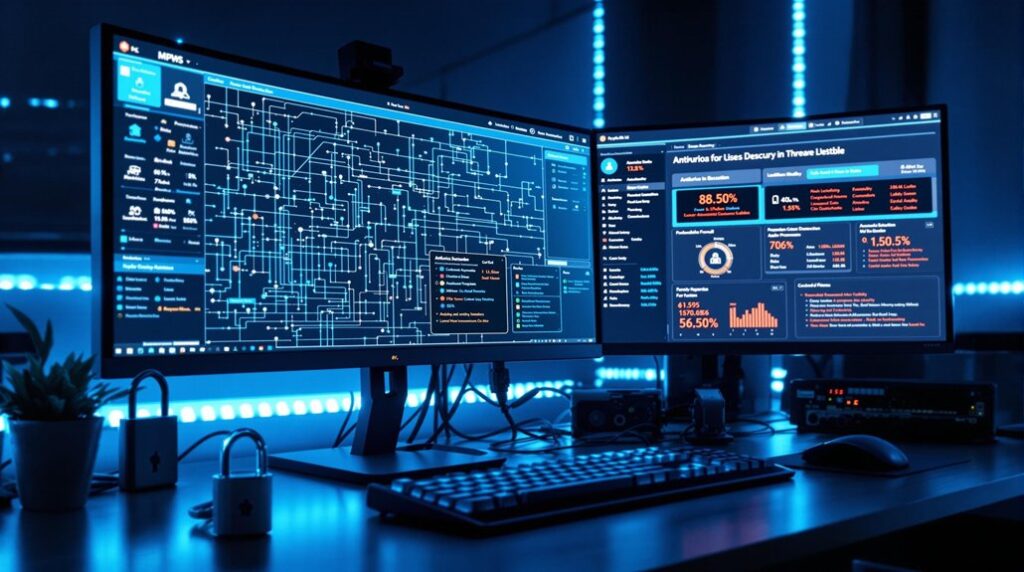The cybersecurity landscape for small businesses in 2025 presents an unprecedented convergence of sophisticated threats. Advanced AI algorithms now power highly targeted attacks, while ransomware operations deploy increasingly complex extortion methods. Cloud misconfigurations and vulnerable legacy systems create critical exposure points. Third-party vendors introduce additional risks through interconnected supply chains. These evolving challenges demand immediate attention as cybercriminals sharpen their focus on smaller, potentially underprepared targets.
Key Takeaways
- AI-driven phishing attacks use hyper-personalized emails to bypass security measures, with 84% of UK small businesses experiencing attempts in 2024.
- Ransomware with double extortion schemes targets smaller companies, encrypting data and threatening public exposure of sensitive information.
- Third-party vendor security breaches account for over half of data breaches, exploiting weak points in supply chain relationships.
- Misconfigured cloud environments and access controls create significant vulnerabilities, causing 84% of identity-related security breaches.
- Legacy systems and outdated software remain prime targets for cybercriminals, with one-third of SMEs still operating unsupported technologies.
AI-Powered Phishing and Social Engineering Attacks
How are cybercriminals revolutionizing their attack strategies? Through ai-powered phishing and sophisticated social engineering attacks, threat actors are deploying hyper-personalized emails that convincingly mimic legitimate communications.
In 2024, 84% of UK small businesses experienced phishing attempts, signaling a vital shift in cybersecurity threats.
These advanced attacks leverage artificial intelligence to analyze communication patterns and create deceptive messages that bypass traditional security measures.
To combat this evolving threat landscape, organizations must implement thorough employee training programs focused on recognizing sophisticated phishing attempts.
Additionally, deploying robust email filtering tools and enforcing multi-factor authentication are essential safeguards against data exposure.
While technological solutions are important, addressing human error remains paramount, as social engineering tactics become increasingly refined and harder to detect.
Ransomware and Double Extortion Schemes
While AI-powered phishing attacks pose significant risks, ransomware has emerged as an equally devastating threat to small businesses.
With 82% of attacks targeting companies under 1,000 employees, cybercriminals increasingly exploit organizations perceived to have weaker cybersecurity measures.
The rise of double extortion schemes has intensified security threats, as attackers not only encrypt data but threaten to expose sensitive information publicly. This creates heightened operational risk, with 75% of SMBs indicating potential business failure following such data breaches.
The impact is particularly severe when critical systems and customer data are compromised.
To combat these evolving threats, organizations must implement thorough backup strategies. Regular encrypted backups, stored securely offline, provide essential protection against ransomware attacks and help guarantee business continuity when traditional security measures fail.
Supply Chain and Vendor Security Breaches
As cybercriminals evolve their tactics, supply chain vulnerabilities have become a critical entry point for attacks on small businesses. Recent data shows that 61% of cyberattacks targeting small businesses exploit weaknesses in third-party vendor relationships, highlighting a significant security gap in current risk management practices.
The impact of inadequate vendor security is substantial, with over half of data breaches in 2023 stemming from compromised third-party vendors.
Small businesses must implement robust cybersecurity practices, including thorough vendor assessments and network segmentation. Effective access controls for third-party vendors are essential to minimize potential security risks.
Organizations should establish stringent risk management protocols that evaluate vendor cybersecurity standards, monitor ongoing compliance, and maintain clear security boundaries between internal networks and external partners.
Cloud Configuration and Access Control Vulnerabilities
Poorly configured cloud environments present one of the most significant cybersecurity risks for small businesses today. Exposed storage buckets and weak access controls create vulnerabilities that threat actors can exploit, leading to unauthorized access and data breaches.
Research indicates that 84% of identity-related breaches stem from misconfigured access controls in small business environments.
The widespread use of unsupported operating systems and legacy software, affecting over one-third of small businesses globally, compounds these cloud configuration challenges.
To mitigate security risks, organizations must implement robust vulnerability management practices, including regular patching cycles and thorough cloud resource inventory maintenance.
Multi-factor authentication deployment across critical systems serves as a vital defense mechanism against account takeovers, while strict access control protocols help prevent unauthorized system access and potential data compromise.
Legacy System and Outdated Software Exploits
Despite widespread digital modernization efforts, legacy systems and outdated software remain pervasive security vulnerabilities for small businesses, with over one-third of SMEs globally operating unsupported technologies in 2023.
These outdated systems present attractive targets for cybercriminals who exploit known security flaws, particularly when regular patching cycles are neglected.
The risks extend beyond traditional system vulnerabilities, as evidenced by the 84% of organizations that experienced identity-related breaches due to weak access controls commonly found in legacy systems.
To mitigate these threats, organizations must implement monthly patching cycles at minimum and consider shifting to cloud-based environments.
This strategic change not only enhances security measures but also provides automated updates and robust access controls, effectively reducing the risk exposure associated with outdated software and legacy infrastructure.
Frequently Asked Questions
What Are the Threats to Cybersecurity in 2025?
Advanced phishing scams, ransomware attacks, insider threats, IoT vulnerabilities, cloud security breaches, data theft, social engineering schemes, evolving malware, cyber insurance gaps, and remote work exploits threaten cybersecurity infrastructure.
What Are the 5 Main Threats to Cyber Security?
Advanced phishing attacks, sophisticated ransomware threats, insider threats through negligence, supply chain vulnerabilities exploiting third-party vendors, and credential-based attacks targeting password weaknesses constitute primary cybersecurity challenges facing organizations.
What Is the Cyber Report 2025?
The Cyber Report 2025 analyzes emerging cyber trends, documenting increased data breaches, phishing attacks, and ransomware incidents while providing strategic recommendations for security measures, compliance regulations, and incident response protocols.
What Is April 2025 Cyber Attack?
The April 2025 cyber attack represents a convergence of sophisticated phishing tactics, ransomware evolution, and insider threats, exploiting IoT vulnerabilities and cloud security weaknesses while challenging regulatory compliance across the cybersecurity landscape.
Conclusion
The cybersecurity landscape of 2025 demands proactive vigilance from small businesses against sophisticated threats. Organizations must implement extensive security frameworks encompassing AI-detection capabilities, robust access controls, and systematic vendor assessments. Regular security audits, coupled with modernized infrastructure and incident response protocols, will prove critical in safeguarding operations against evolving attack vectors and minimizing potential business disruptions.





